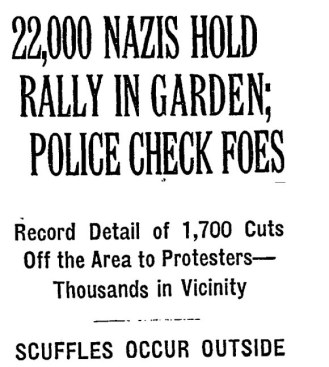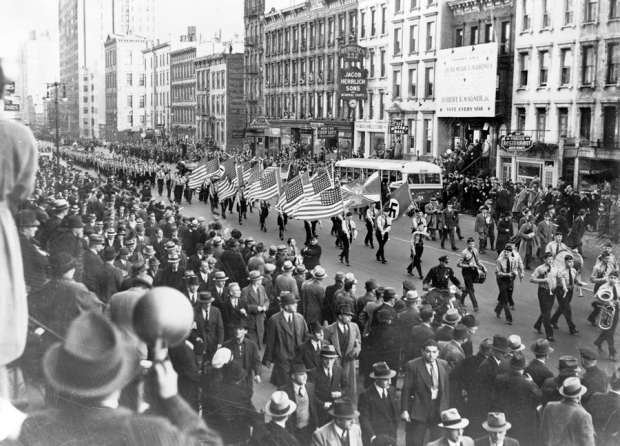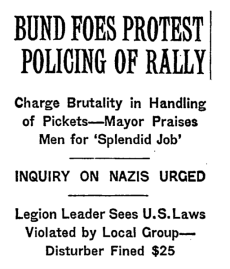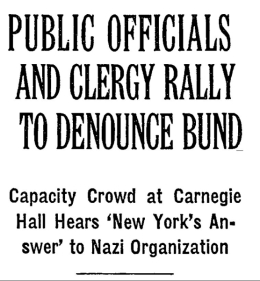In 1939, 20,000 Americans rallied in New York’s Madison Square Garden to celebrate the rise of Nazism – an event largely forgotten from American history. A NIGHT AT THE GARDEN, a short film by Marshall Curry just nominated for an Oscar, is made entirely from archival footage filmed that night, transporting audiences to this chilling gathering and shines a light on the power of demagoguery and anti-Semitism in the United States.
A Q&A with director Marshall Curry
Q: How did you discover this event?
A: A friend of mine told me about it last year, and I couldn’t believe that I’d never heard of it. When I found out it had been filmed, I asked an archival researcher, Rich Remsberg, to see what he could find. It turned out that short clips had been used in history documentaries before, but no one seemed to have collected together all of the scraps of footage – there was some at the National Archives, some at UCLA’s archive, some at other places. So he gathered it, and I edited it together into a short narrative. When Charlottesville happened, it began to feel urgent. So I sent it over to Laura Poitras and Charlotte Cook at Field of Vision and said, “Have you ever heard of this event? Would you be interested in supporting the film?” And they jumped on board.
 Click for article. |
Q: What struck you about the footage?
A: The first thing that struck me was that an event like this could happen in the heart of New York City, a city that was diverse, modern, and progressive even in 1939. The second thing that struck me was the way these American Nazis used the symbols of America to sell an ideology that a few years later hundreds of thousands of Americans would die fighting against.
It really illustrated that the tactics of demagogues have been the same throughout the ages. They attack the press, using sarcasm and humor. They tell their followers that they are the true Americans (or Germans or Spartans or…). And they encourage their followers to “take their country back” from whatever minority group has ruined it.
Q: Why do you think that most Americans have never heard of this group or this event?
A: The footage is so powerful, it seems amazing that it isn’t a stock part of every high school history class. But I think the rally has slipped out of our collective memory in part because it’s scary and embarrassing. It tells a story about our country that we’d prefer to forget. We’d like to think that when Nazism rose up, all Americans were instantly appalled. But while the vast majority of Americans were appalled by the Nazis, there was also a significant group of Americans who were sympathetic to their white supremacist, anti-Semitic message. When you see 20,000 Americans gathering in Madison Square Garden, you can be sure that many times that were passively supportive.
 |
In a part of Fritz Kuhn’s speech that isn’t in the film, he applauds Father Coughlin, whose radio shows praising Hitler and Mussolini reached audiences of 30 million Americans. Henry Ford and Charles Lindbergh expressed anti-Semitic beliefs. And press magnate William Randolph Hearst declared, “Whenever you hear a prominent American called a fascist, you can usually make up your mind that the man is simply a loyal citizen who stands for Americanism.” (In a small ironic twist, we licensed some of the Bund footage from the Hearst collection at UCLA.)
These were ideas that, if not universally accepted, were at least considered legitimate points of view. But two years after this rally, Japan attacked Pearl Harbor and Germany declared war on the U.S. And at that point this sort of philosophy became unacceptable. When the Nazis began killing American soldiers, we started erasing the fact that any Americans had ever shared their philosophy.
In the end, America pulled away from the cliff, but this rally is a reminder that things didn’t have to work out that way. If Roosevelt weren’t President, if Japan hadn’t attacked, is it possible we would have skated through without joining the war? And if Nazis hadn’t killed American soldiers, is it possible that their philosophy wouldn’t have become so taboo here?
Q: Who was the guy who ran out on stage during the rally?
A: He was a 26-year-old plumber’s helper from Brooklyn named Isadore Greenbaum. When he ran on stage to protest, he was beaten up and had his pants ripped off as he was thrown from the stage. He was also arrested for disorderly conduct and fined $25.
There was a debate at the time over whether the Bund should be allowed to have a rally, which – like so many things about the event – seems eerily contemporary. Greenbaum explained to the judge the day after the rally, “I went down to the Garden without any intention of interrupting. But being that they talked so much against my religion and there was so much persecution I lost my head, and I felt it was my duty to talk.” The Magistrate asked him, “Don’t you realize that innocent people might have been killed?” And Greenbaum replied, “Do you realize that plenty of Jewish people might be killed with their persecution up there?” (New York Times, 2/22/39).
 Click for article. |
But in The New York Times, the American Jewish Committee argued that although the Bund was “completely anti-American and anti-Democratic… because we believe that the basic rights of free speech and free assembly must never be tampered with in the United States, we are opposed to any action to prevent the Bund from airing its views.” Mayor LaGuardia, for his part, ridiculed the event as an “exhibition of international cooties,” and said he believed in exposing cooties to the sunlight. Here is a terrific article on Greenbaum from the Washington Post.
Q: What happened to this group after this rally?
A: The German American Bund, who held the rally, had a significant presence in the 1930s, with youth camps and training camps in New Jersey, upstate New York, Wisconsin, and Pennsylvania, and a huge march down East 86th Street in Manhattan. But their mainstream appeal was reduced by their leaders’ German accents and culture.
As Halford E. Luccock famously said, “When and if fascism comes to America it will not be labeled ‘made in Germany’; it will not be marked with a swastika; it will not even be called fascism; it will be called, of course, ‘Americanism.’” The group’s leader Fritz Kuhn was eventually arrested for embezzling Bund funds and sent to prison and stripped of his citizenship. After the war, he was deported to West Germany where he died a few years later. The Bund disappeared soon after the start of World War II.
Q: How did you decide on the editing approach?
A: At first I thought I’d make a traditional documentary – with an historian explaining the background of the group. But when I started cutting the footage together, I realized there was real power in just watching it unfold, without explanation. When most people watch it, at first they are puzzled: “What is this?” They see George Washington and American flags and hear the Pledge of Allegiance (notably, before the phrase “Under God” was added in 1954), but then they see swastikas and people giving the Nazi salute, and it’s really unsettling. So I decided to keep it pure and cinematic and unmediated – as if you are there, watching, and wrestling with what you are seeing. I wanted it to be more provocative than didactic – an icy splash of history tossed into the discussion we are having about white supremacy right now.
 Click for article. |
Q: What do you want the audience to take away from the film?
A: The film doesn’t have narration or interviews to clearly underline the takeaways, but I think most audiences will find lots to chew on. To me, the most striking and upsetting part of the film is not the anti-Semitism of the main speaker or even the violence of his storm-troopers. What bothers me more is the reaction of the crowd. Twenty-thousand New Yorkers who loved their kids and were probably nice to their neighbors, came home from work that day, dressed up in suits and skirts, and went out to cheer and laugh and sing as a speaker dehumanized people who would be murdered by the millions in the next few years.
This point is less an indictment of bad things that Americans have done in the past than it is a cautionary tale about the bad things that we might do in the future. When the protester is being beaten up there’s a little boy in the crowd who I zoomed on in the edit. You can see him rub his hands together, doing an excited little dance, unable to contain the giddy excitement that comes from being part of a mob. And when the protester is finally thrown off stage, there’s a long slow pan across the crowd that is laughing, clapping, cheering, like they’re at a World Wrestling Federation match.
We’d like to believe that there are sharp lines between good people and bad people. But I think most humans have dark passions inside us, waiting to be stirred up by a demagogue who is funny and mean, who can convince us that decency is for the weak, that democracy is naïve, and that kindness and respect for others are just ridiculous political correctness. Events like this should remind us not to be complacent – that the things we care about have to be nurtured and defended regularly – because even seemingly good people have the potential to do hideous things.
A Q&A with Marshall Curry is reprinted from the official "A Night at the Garden" website.
Add new comment